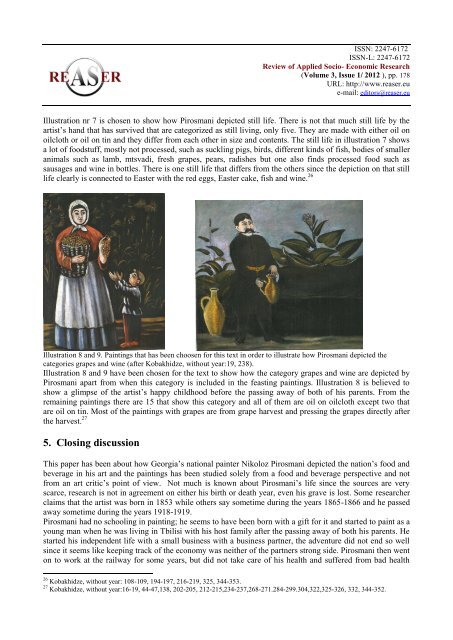Volume 3, ISSUE1/2012 - Review of Applied Socio-Economic ...
Volume 3, ISSUE1/2012 - Review of Applied Socio-Economic ...
Volume 3, ISSUE1/2012 - Review of Applied Socio-Economic ...
Create successful ePaper yourself
Turn your PDF publications into a flip-book with our unique Google optimized e-Paper software.
ISSN: 2247-6172<br />
ISSN-L: 2247-6172<br />
<strong>Review</strong> <strong>of</strong> <strong>Applied</strong> <strong>Socio</strong>- <strong>Economic</strong> Research<br />
(<strong>Volume</strong> 3, Issue 1/ <strong>2012</strong> ), pp. 178<br />
URL: http://www.reaser.eu<br />
e-mail: editors@reaser.eu<br />
Illustration nr 7 is chosen to show how Pirosmani depicted still life. There is not that much still life by the<br />
artist’s hand that has survived that are categorized as still living, only five. They are made with either oil on<br />
oilcloth or oil on tin and they differ from each other in size and contents. The still life in illustration 7 shows<br />
a lot <strong>of</strong> foodstuff, mostly not processed, such as suckling pigs, birds, different kinds <strong>of</strong> fish, bodies <strong>of</strong> smaller<br />
animals such as lamb, mtsvadi, fresh grapes, pears, radishes but one also finds processed food such as<br />
sausages and wine in bottles. There is one still life that differs from the others since the depiction on that still<br />
life clearly is connected to Easter with the red eggs, Easter cake, fish and wine. 26<br />
Illustration 8 and 9. Paintings that has been choosen for this text in order to illustrate how Pirosmani depicted the<br />
categories grapes and wine (after Kobakhidze, without year:19, 238).<br />
Illustration 8 and 9 have been chosen for the text to show how the category grapes and wine are depicted by<br />
Pirosmani apart from when this category is included in the feasting paintings. Illustration 8 is believed to<br />
show a glimpse <strong>of</strong> the artist’s happy childhood before the passing away <strong>of</strong> both <strong>of</strong> his parents. From the<br />
remaining paintings there are 15 that show this category and all <strong>of</strong> them are oil on oilcloth except two that<br />
are oil on tin. Most <strong>of</strong> the paintings with grapes are from grape harvest and pressing the grapes directly after<br />
the harvest. 27<br />
5. Closing discussion<br />
This paper has been about how Georgia’s national painter Nikoloz Pirosmani depicted the nation’s food and<br />
beverage in his art and the paintings has been studied solely from a food and beverage perspective and not<br />
from an art critic’s point <strong>of</strong> view. Not much is known about Pirosmani’s life since the sources are very<br />
scarce, research is not in agreement on either his birth or death year, even his grave is lost. Some researcher<br />
claims that the artist was born in 1853 while others say sometime during the years 1865-1866 and he passed<br />
away sometime during the years 1918-1919.<br />
Pirosmani had no schooling in painting; he seems to have been born with a gift for it and started to paint as a<br />
young man when he was living in Tbilisi with his host family after the passing away <strong>of</strong> both his parents. He<br />
started his independent life with a small business with a business partner, the adventure did not end so well<br />
since it seems like keeping track <strong>of</strong> the economy was neither <strong>of</strong> the partners strong side. Pirosmani then went<br />
on to work at the railway for some years, but did not take care <strong>of</strong> his health and suffered from bad health<br />
26 Kobakhidze, without year: 108-109, 194-197, 216-219, 325, 344-353.<br />
27 Kobakhidze, without year:16-19, 44-47,138, 202-205, 212-215,234-237,268-271.284-299.304,322,325-326, 332, 344-352.








